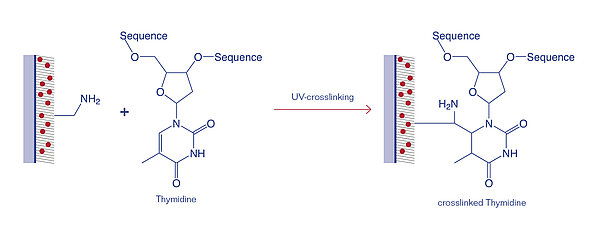Amine Surfaces
for coupling via electrostatical adsorption of negatively charged biochemical species

An adsorptive immobilization is a non-covalent coupling method on solid supports which is realized by electrostatic and Van-der-Waals interactions as well as hydrogen bonds and hydrophobic interactions of the reactants. An electrostatic interaction is formed by an ion-ion-interaction between the surface and the applied biochemical species. The dissociation energy for typical electrostatic bond is 130 kJ/mol, which is about a third of the strength of an average covalent bond. In order to achieve an optimal adhesion the probe buffer und the adhesion conditions (pH-value) have to be optimized.
Binding of oligonucleotides on the 3D-Amino matrix
Oligonucleotides can be bound electrostatically on the 3D-Amino surface with their negatively charged backbone or their 5´-phosphate group. For immobilization of oligonucleotides we recommend an additional UV-crosslinking after adsorption. During the UV irradiation the nucleic base Thymine forms radicals which undergo H-abstraction in the 3D-Matrix to form a covalent bond.

Products
PolyAn equips glass slides, coverslips and polymer slides with 3D-Amino surfaces. Additionally, PolyAn has a range of porous materials (membranes, fleece and sinter materials) and microparticles in our product portfolio that are functionalised with 3D-Amino surfaces.
Please do not hesitate to contact us, if you would like to functionalise a different format or substrate with our 3D-Amino surface.
Selected Publications
Amine surface for the immobilization of Oligonucleotides (DNA/RNA):
- Schaudy, E. et al., `Nonaqueous Oxidation in DNA Microarray Synthesis Improves the Oligonucleotide Quality and Preserves Surface Integrity on Gold and Indium Tin Oxide Substrates´, Anal. Chem., 2024, 96, 2378. DOI: 10.1021/acs.analchem.3c04166.
Amine surface for the immobilization of Peptides:
- Schmidt, D. et al., `Label-Free Imaging of Solid-Phase Peptide Synthesis Products and Their Modifications Tethered in Microspots Using Time-of-Flight Secondary Ion Mass Spectrometry´, Int. J. Mol. Sci., 2023, 24, 15945. DOI: 10.3390/ijms242115945.
Amine surface for the immobilization of Proteins and Antibodies:
- DiNatale, C. et al., `Optimization of Chemical Protein Conjugation on Activated Glass Surfaces for the Development of an Innovative Biosensor for Testing Astronaut Health Biomarkers at Picogram Levels During Spaceflight´, SSRN, 2023, DOI: 10.2139/ssrn.4479678 .
- Itri, S. et al., `A pin-based pyro-electrohydrodynamic jet sensor for tuning the accumulation of biomolecules down to sub-picogram level detection´, Sens. Bio-Sens. Res., 2022, 38, 100536. DOI: 10.1016/j.sbsr.2022.100536.
Amine surface for the immobilization of Glycans:
- Tsouka, A. et al., `VaporLIFT: On-Chip Chemical Synthesis of Glycan Microarrays´, Adv. Funct. Mater., 2024, 2024, 2310980. DOI: 10.1002/adfm.202310980.
- Tsouka, A. et al., `Probing Multivalent Carbohydrate-Protein Interactions With On-Chip Synthesized Glycopeptides Using Different Functionalized Surfaces´, Front. Chem., 2021, 9, 766932. DOI: 10.3389/fchem.2021.766932.
